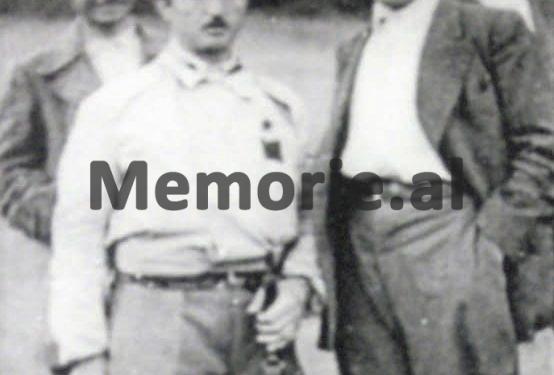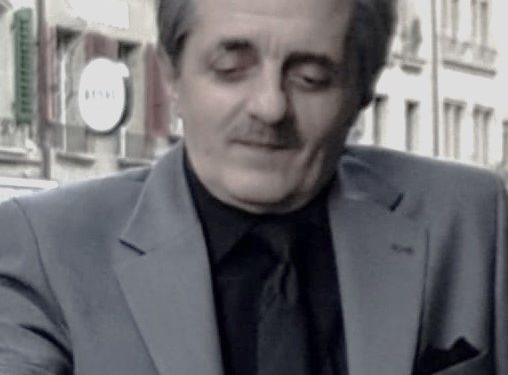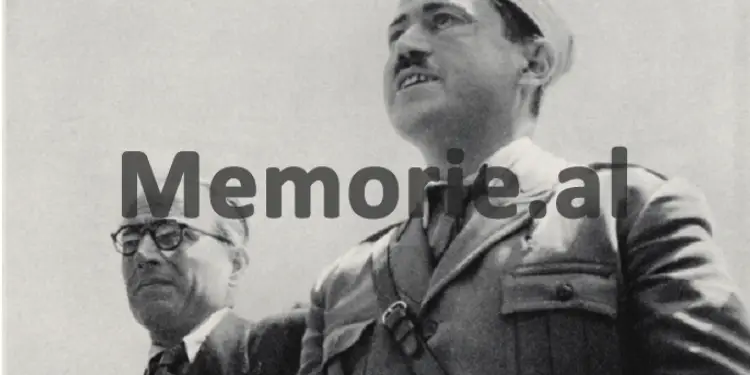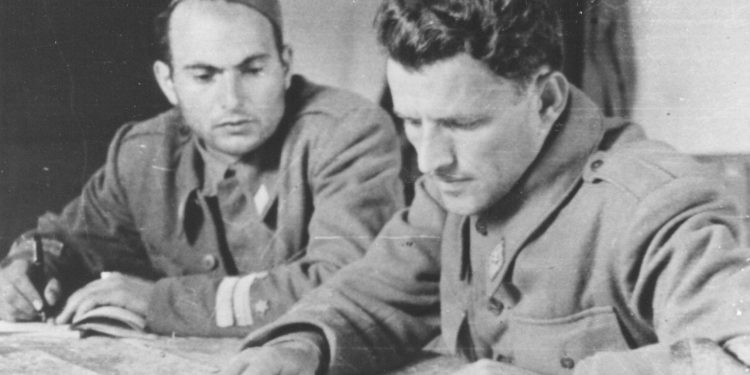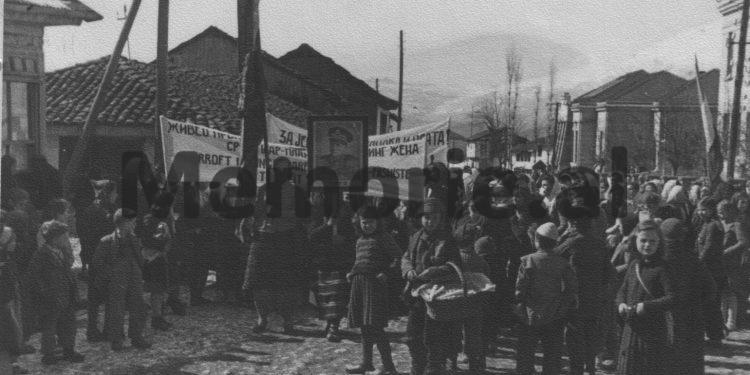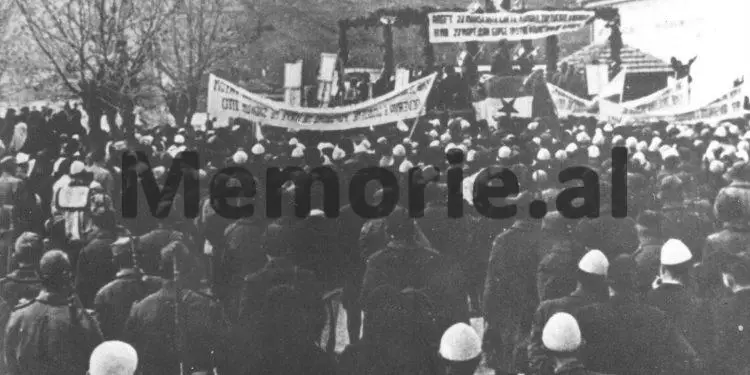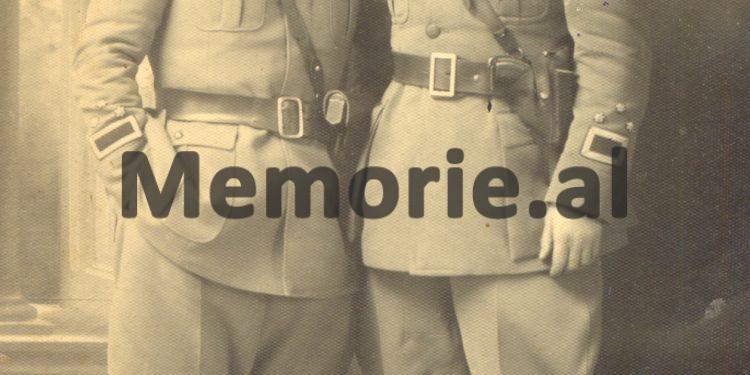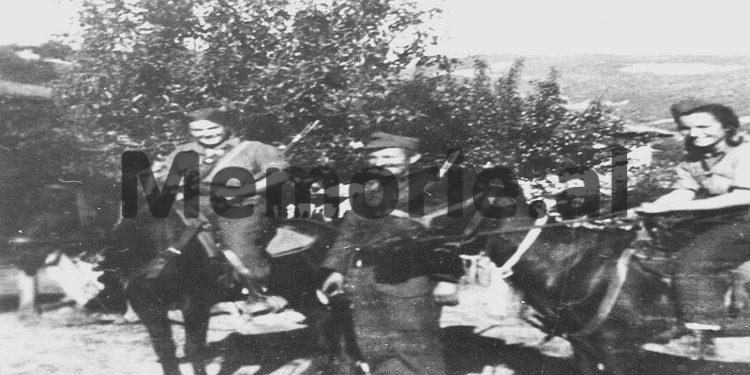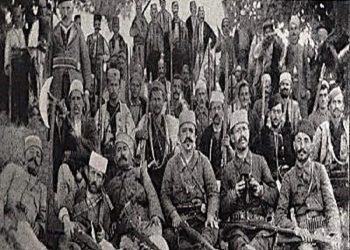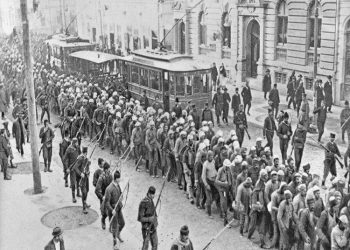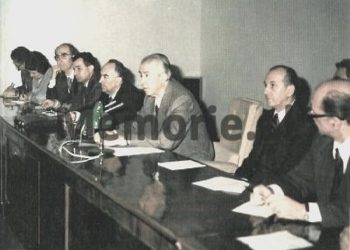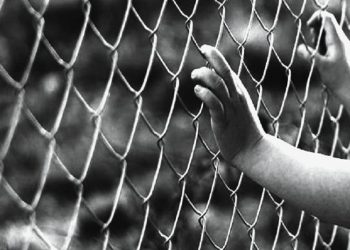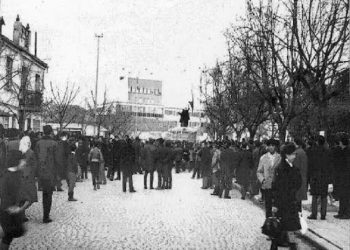THE BLLACË MASSACRE IN KARADAK OF SKOPJE: FRIGHTENING TESTIMONY OF SLAVO-MACEDONIAN ANTI-ALBANIANISM –
Memorie.al / The inhabitants of Albanian Macedonia, just like our entire people, during the Second World War, knew how to align themselves with the forces that fought Nazism and Fascism, for freedom, independence, and ethnic borders, according to the rights of the civilized world. The legitimate aspiration for national unification would never be granted to our nation; on the contrary, it would be denied at every moment, even when political forces within the mother state and outside it aligned themselves with the Allies. Thus, while Albanians were lined up on the great front of the war for freedom and shed their blood, the leadership of the Communist Party of Yugoslavia conceived other chains of slavery and endless hardships for the Albanians in Belgrade.
I believe that a serious review of the so-called Balkan Federation and the Balkan Military Staff, with the participation of Slavic, Greek, and Albanian communists, will lead us to the idea of an entirely open chauvinism, even before the end of the Second World War. According to Tempo’s own memoirs, the Yugoslav representative in these meetings, Belgrade, regarding the continuity of the Inter-Balkan Staff, demanded, among other things:
- “The development of the National Liberation War in Kosovo and Macedonia.”
- “The creation of unity in military action of all communist national liberation forces of the Balkan countries.”
- “It demands that chauvinistic divisions between the peoples of the Balkans be overcome until the complete victory of communist democracy and the creation of the Balkan Confederation.”
- “It demands the engagement of Albanian units to raise the Albanian people of Kosovo and those included in the Vardar Banovina into the war.”
- “It demands that the supreme headquarters of the Balkan states declare themselves in favor of accepting the right of the Macedonian people to self-determination.”
(Tempo, “Revolucija koja teçe”, book III, Belgrade, p. 85)
So, despite the false propaganda in Kosovo and the regions of Albanian Macedonia, chauvinistic Belgrade was very clear about the future of the peoples it would lead, through the grotesque butaforie of proletarian internationalism. It is easy to understand that behind the phrase “chauvinistic divisions,” chauvinistic Belgrade meant precisely the just struggle of Albanian nationalism to live free in its own ethnic lands. It foresaw as chauvinism the creation of a national government in the mother state, just as it foresaw the creation of the High Civil Commissariat for the Liberated Lands, the formations of the Albanian National Defense in the hands of the leadership of the Second League of Prizren, etc.
At the same time, the Yugoslav representatives, in the tripartite meeting in question, requested the signing of the establishment of the Slavo-Macedonian people, even though their representative was not only absent but they were generally not recognized as a nation at all. And the most extreme paradox was the so-called “communist democracy,” which meant fratricidal war among Albanians for chauvinistic Belgrade to establish its own power in Kosovo, through the communist clique of Fadil Hoxha and Ali Shukriu, and then the colonization of Albanian Macedonia by declaring a population “a nation” whose name fits the name of a fatherless child thrown into a trash can, but which in growth would turn into a monster. If this were only the position of the Yugoslav side, this would be only half the evil.
But in a completely shameful and absurd way, this was also the position of the communist clique of the mother state in Tirana, a clique which was strengthening its positions, thanks to the unreserved support (on the ideological level) of Belgrade and Moscow. Thus, while Enver Hoxha was sending Haxhi Lleshi to the “Vardar Banovina,” among other things, he instructed that the Albanian national liberation formations must expose all those who championed the issue of Ethnic Albania, as this would be decided by the people themselves after the war. Meanwhile, the political commissar of the First Assault Division, Hysni Kapo, with a special radiogram, instructed Albanian communists to fight by all means (implying also with violence), the manifestations of nationalism in the ranks of the Albanian national liberation fighters.
It is now known that on the eve of Bulgaria’s capitulation, the political and military situation in the regions of Albanian Macedonia would undergo further changes. Faced with such facts, the Čubrilovićes could not remain silent. The Supreme Headquarters of Yugoslavia urgently sent a whole squad of political and military cadres to these regions, which, with their experience, would take over the local government after the departure of the Bulgarian troops, as well as try to reduce the influence of nationalists in this Albanian area.
In truth, with the complete collapse of the Bulgarian monarchy, many war criminals or born and rabid anti-Albanians, who until that time had served Bulgaria, now rushed to enlist in the ranks of the “Macedonian national liberation fighters.” Despite the fact that they knew well the crimes committed by their side, they were not only accepted into the ranks of the Slavic communists in their criminal squads but were also given high ranks in the military hierarchy, in which case the latter would be in the front ranks of terror against the defenseless population in the ethnic Albanian regions of Macedonia.
On September 2, 1944, the Supreme Headquarters of the Yugoslav National Liberation Army made the infamous decision to transform the Main Headquarters of Kosovo into the Operational Headquarters, and almost two weeks later, with another arbitrary decision, the Operational Headquarters in question was placed under the main dependency of the Main Headquarters of Serbia. Immediately after these two decisions, thousands and thousands of regular soldiers of Serbian military formations, Četniks, and all kinds of criminals would rush into the regions of Albanian Macedonia, solely to completely shatter and annihilate the Albanian resistance, which was being organized most effectively by nationalists, both in the mother state and in Kosovo and Albanian Macedonia.
In his book, “Organizimi, përbërja dhe veprimi i aradhave partizane në vitet 1943-1944” (Organization, composition and action of partisan squads in the years 1943-1944), Aleksandar Spasovski, with a hateful account of Albanian nationalists, admits the Slavic communist crime when he says that in the summer of 1944, in Karadak of Skopje and its surroundings, the Četnik units of Draža Mihailović, commanded by Nikodin Urdarević, were operating. “During September–October, these combat formations waged fierce and successful battles against Ballist forces,” according to him.
Thus, we arrive at the massacre committed on the night of Bajram (Eid al-Fitr) on November 16, 1944. But why was this particular village chosen for all that physical terror to be carried out?! This question can lead to various speculations, but in any case, if one observes the theater of combat operations of that time in the regions of Albanian Macedonia, one is easily convinced that the act in question was a continuation of the systematic violence against Albanians for their denationalization, the annexation of Albanian lands, and above all, these crimes paved the way for the rise of a non-existent nation. But naturally, this massacre may have also been hastened by the successes that the nationalist forces led by Mulla Idriz Gjilani had, which resulted in hundreds of dead and wounded among the partisan and Četnik squads.
In fact, B. Gola, a former officer in the national liberation squads, seems to be of this opinion, who, speaking about the causes of the Bllacë massacre, writes: “There we learned that the fighters of Mulla Idriz Gjilani had repulsed the 17th Macedonian Brigade as an act of revenge for the crimes committed against the innocent people, and that the 16th Brigade (or as they called it then; the Serbo-Četnik brigade of Montenegro and Skopje) was completely shattered. The 16th Macedonian Brigade, thus shattered, arrived in an Albanian village in Skopje, in Bllacë, and in an act of revenge, slaughtered almost all the males in the village, even though they had no connection to the combat events that had taken place in Gjilan.” (“Flaka e Vëllazërimit” newspaper, February 27, 1997, Skopje).
So, although shattered, the Serbo-Četniks and their Slavo-Macedonian brothers, just like that beast in its death throes that only seeks blood, managed to enter Bllacë, with about 300-350 well-armed forces. There, they called for all males to gather in the village square, as something would be communicated to them. The attempt of the first villager who wanted to break the cordon ended with his immediate execution. After this, the inhabitants of Bllacë foresaw that it was impossible to resist. After they had all gathered, they were tied with barbed wire or rifle straps, and whoever resisted was covered in blood from the beatings.
At the place called Arat e Bardhëve (The Whites’ Fields), someone asked a Slavo-Macedonian officer where they were being taken. Eyewitnesses to the event recount that he was immediately shot and, because he was tied to his own son, his son was also fatally shot. After this, every one of the defenseless villagers of Bllacë understood the butchery that awaited them. One of the witnesses to the event, Haxhi Emin Bardhi, recounts, among other things: “We did not walk even 10-15 meters and again the first soldiers would take the tied-up men and shoot them there, in a pit, while those of us in the last rows were told: ‘Look how we shoot them, your turn will come too.’
My turn came too. They ordered me to stop and fired at me. I fell to the ground, and I saw how the bullets were coming all around me, but they did not hit me. It is interesting that I did not feel any fear of death. I experienced the only fear when I saw a soldier coming towards me. He kicked me (I pretended to be dead) and left. There, Nuhi Koka, Sadriu i Bislimit, Mustafë Zeka, and Sali Kovaçi escaped first, towards the river. Lying there, I heard the shots near Uji i Thartë (Sour Water) and guessed that they were killing. Fasli Amati was near me, whose father and brother had been killed.
I couldn’t cut the rope. My hands were heavily covered in blood. I couldn’t even reach my belt. Suddenly, I heard a sigh; it was Fasli Amati. I realized he was alive. His arm had been injured. I asked him to turn his back. He did so. I crawled onto the dead people near me and untied Fasli’s rope. Then he wanted to untie me, but since his right hand was wounded, he could not undo the knot with one hand at all. I remembered that I had a penknife (small knife) in my pocket. Fasliu grabbed it with his teeth and cut my belt. After I was free, we made the newly dead Rasim a burial shroud and fled to the mountain” (F. Curri “Fati ynë në peshojë”, Skopje 1994, pages 32-33).
I see fit to include in these notes the names of a significant portion of the innocent villagers of Bllacë, who were martyred by the bloody hand of the Slavo-Macedonian communist-Četniks. There are several sources where these names can be found, but in any case, our historiography agrees on the idea that due to the years that have passed, the collective grave, or the pronounced lack of records in these areas, this list can by no means be complete. However, the martyrs who are known are:
1-Qamil Jakupi 32-Sami jahiu 63-Sabedin Sinani 94-Avdil Bardhi
2-Shabi Jakupi 33-Mustafë Aliu 64-Jonuz Beqiri 95-Zelfi Bardhi
3-Haki Jmishi 34-Mirtezan Mynishi 65-Rushit Qahili 96-Rustem Bardhi
4-Tahir Jmishi 35-Ziber Sefa 66-Jahi Qahili 97-Mustafë Bardhi
5-Eshref Jmishi 36- Xhevid Osmani 67-Mehmet Toçi 98-Zajdin Bardhi
6-Sinan Luçi 37-Behar Sula 68-Rrahman Ahmeti 99-Hebib Bardhi
7-Daut Luçi 38-Lush Elmazi 69-Osman Ahmeti 100-Kurtish Bardhi
8-Hamid Luçi 39-Brahim Rahmani 70-Naip Ahmeti 101-Idriz Ferra
9-Sherif Luçi 40-Rrahman Kovaçi 71-Beran Ajeti 102-Xhevit Ferra
10-Tanush Metushi 41-Miftar Kovaçi 72-Hazis Shima 103-Brahim Ferra
11-Halim Metushi 42-Hamdi Hasani 73-Rushan Isufi 104-Milaim Ferra
12-Mustafë Shehu 43-Qazim Hasani 74-Azem Bislimi 105-Hasan Ferra
13-Mihal Domi 44-Muharrem Berani 75-Ismail hasani 106-Qamil Ferra
14-Sejfulla Shehu 45-Shaban Sinani 76-Islam Saliu 107-Rushit Ferra
15-Ali Shehu 46-Hamdi Sinani 77-Sabit Saliu 108-Shukri Ferra
16-Ali Tahiri 47-Nebi Brahimi 78-Rushit Nuredini 109-Daut Ferra
17-Beram Kurtishi 48-Rifat jahiu 79-Xhelil Nuredini 110-Nuhi Ferra
18-Hazis Sefa 49-Alush jahiu 80-Vehbi Ismaili 111- Riza Doçi
19-Halit Sefa 50-Jonuz Hasani 81-Sinan Haliti 112- Hazis Doçi
20-Ramadan Ibrahimi 51-Rasim Hasani 82-Kasam Haliti 113-Islam Doçi
21-Betush Ismaili 52-Naip Mysliu 83-Memish Amati 114-Muharrem Doçi
22-Hamil Hasani 53-Jehi Ferati 84-Halil Amati 115-Shaqip Doçi
23-Ismail Veliu 54-Shukri Beqiri 85-Arif Amati 116-Emin Doçi
24-Mehmet Veliu 55-Sabedin Ramadani 86-Rasim Amati 117-Xhemal Doçi
25-Refat Brahimi 56-Latif Ramadani 87-Ibish Amati 118-Nebi Doçi
26-Abedin Bafti 57-Fariz Saliu 88-Metush Amati 119-Avdi Doçi
27-Raif Elmazi 58-Bektash Rustemi 89-Hashim Amati 120 deri më 127 ??
28-Halim Avdyli 59-Nezir Miftari 90-Zylbejar Amati
29-Junuz Elmazi 60-Beram ramizi 91-Fasli Bardhi
30-Metush Islami 61-Zenun Fetahi 92-Sahit Bardhi
31-Xhemal Sula 62-Asllan Fetahi 93-Ali Bardhi ………………………
The Bllacë Massacre can by no means be seen in isolation from other inhuman massacres committed by the Slavo-Macedonians in the regions of Albanian Macedonia. In truth, it began in November 1944 and continued for decades afterward. Serbo-Slavo-Macedonian communist propaganda, and why not that of the Albanian communists too, tried to keep this massacre in the dark, writing in their press about “some killed in Bllacë, members of the ‘Balli Kombëtar’ (National Front) and collaborators of the enemy.” In reality, the list of names, which includes individuals of almost childlike ages, tells the opposite of what Slavo-communist historiography attempts to explain.
Immediately after the establishment of the Slavo-Macedonian communist power in January 1945, dozens of houses in Bllacë were burned, Albanian-language schools were closed, and any remaining villagers who sought to speak about the tragedy of Uji i Thartë (Sour Water) were imprisoned and brutally tortured in the casemates of Idrizovo and even in the distant Goli Otok. The bones of the martyrs of Bllacë have now been raised in a memorial monument to the martyrs; they are now honored by the nation and honored by God, yet they still cry out for vengeance today. Slavo-Macedonian crimes, although not on this scale, are still dangerously manifested today in the ethnic regions of Albanians, in today’s FYROM (Former Yugoslav Republic of Macedonia). Memorie.al




